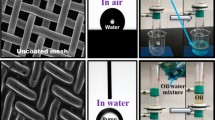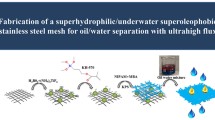Abstract
Due to their low oil adhesion and selective oil–water separation, screens with superhydrophilicity and underwater superoleophobicity have attracted significant attention. However, oil–water separation materials with high efficiency and low cost are still urgently in demand. Here, inspired by natural marine mussels, we prepared a self-healing hydrogel-coated screen to achieve highly efficient oil–water separation. Polydopamine (PDA) was incorporated into polyacrylamide (PAM) and uniformly coated on a stainless steel screen to prepare a self-healing hydrogel-coated screen. The results showed that the PDA-PAM hydrogel coating firmly adhered to the stainless steel screen and exhibited superhydrophilicity and underwater superoleophobicity. Regarding the PDA-PAM hydrogel-modified screen with a coating time of 7 min, different types of oil–water mixtures could be driven by gravity to achieve a highly efficient oil–water separation rate of over 97%, and the water flux could reach 91,673 L m−2 h−1. After ten cycles, the separation efficiency did not decrease significantly, suggesting that the self-healing hydrogel-coated screen has excellent stability and recycling performance. This inexpensive novel filter screen with high efficiency has a wide range of potential application in the field of oil–water separation.








Similar content being viewed by others
References
Chu Z, Feng Y, Seeger S (2015) Oil/water separation with selective superantiwetting/superwetting surface materials. Angew Chem Int Ed 54(8):2328–2338
Jiang T, Guo Z, Liu W (2015) Biomimetic superoleophobic surfaces: focusing on their fabrication and applications. J Mater Chem A 3(5):1811–1827
Shome A, Maji K, Rather AM, Yashwanth A, Patel DK, Manna U (2019) A scalable chemical approach for the synthesis of a highly tolerant and efficient oil absorbent. Chem Asian J 14(24):4732–4740
Cheng J, Hou K, Zhao A, Pi P, Wen X, Xu S (2016) Superhydrophilic and underwater superoleophobic titania nanowires surface for oil repellency and oil/water separation. Chem Eng J 301:249–256
Cao Z, Hao T, Pan W, Zhang Y, Meng J (2017) Surface modified glass fiber membranes with superior chemical and thermal resistance for O/W separation. Chem Eng J 309:30–40
Li Z, Rabnawaz M, Sarwar MG, Khan B, Nair AK, Sirinakbumrung N, Kamdem DP (2019) A closed-loop and sustainable approach for the fabrication of plastic-free oil- and water-resistant paper products. Green Chem 21:5691–5700
Gunatilake UB, Bandara J (2017) Fabrication of highly hydrophilic filter using natural and hydrothermally treated mica nanoparticles for efficient waste oil-water separation. J Environ Manag 191:96–104
Zarghami S, Mohammadi T, Sadrzadeh M (2019) Preparation, characterization and fouling analysis of in-air hydrophilic/underwater oleophobic bio-inspired polydopamine coated PES membranes for oily wastewater treatment. J Membr Sci 582:402–413
Wang Q, Fu Y, Yan X, Chang Y, Ren L, Zhou J (2017) Preparation and characterization of underwater superoleophobic chitosan/poly(vinyl alcohol) coatings for self-cleaning and oil/water separation. Appl Surf Sci 412:10–18
Zarghami S, Mohammadi T, Sadrzadeh M, Bruggen BVd (2019) Superhydrophilic and underwater superoleophobic membranes—a review of synthesis methods. Prog Polym Sci 98:101166
Li J, Yan L, Li W, Li J, Zha F, Lei Z (2015) Superhydrophilic-underwater superoleophobic ZnO-based coated mesh for highly efficient oil and water separation. Mater Lett 153:62–65
Li J, Li D, Li W, Li H, She H, Zha F (2016) Facile fabrication of underwater superoleophobic SiO2 coated meshes for separation of polluted oils from corrosive and hot water. Sep Purif Technol 168:209–214
Dai J, Chang Z, Xie A, Zhang R, Tian S (2018) One-step assembly of Fe(III)-CMC chelate hydrogel onto nanoneedle-like CuO@Cu membrane with superhydrophilicity for oil-water separation. Appl Surf Sci 440:560–569
Wang Y, He Y, Yan S, Yin X, Chen J (2019) Development of alginate hydrogel modified multifunctional filtration membrane with robust anti-fouling property for efficient water purification. Colloids Surf B 582:123891
Gunatilake UB, Bandara J (2017) Efficient removal of oil from oil contaminated water by superhydrophilic and underwater superoleophobic nano/micro structured TiO2 nanofibers coated mesh. Chemosphere 171:134–141
You H, Jin Y, Chen J, Li C (2018) Direct coating of a DKGM hydrogel on glass fabric for multifunctional oil-water separation in harsh environments. Chem Eng J 334:2273–2282
Liu J, Qu S, Suo Z, Yang W (2021) Functional hydrogel coatings. Natl Sci Rev 8:nwaa254
Gan D, Xing W, Jiang L, Fang J, Zhao C, Ren F, Fang L, Wang K, Lu X (2019) Plant-inspired adhesive and tough hydrogel based on Ag-Lignin nanoparticles-triggered dynamic redox catechol chemistry. Nat Commun 10:1487
Song YZ, Kong X, Yin X, Zhang Y, Sun CC, Yuan JJ, Zhu B, Zhu LP (2017) Tannin-inspired superhydrophilic and underwater superoleophobic polypropylene membrane for effective oil/water emulsions separation. Colloids Surf A 522:585–592
Xiang Y, Fu L, Xue L (2015) Under seawater superoleophobic PVDF membrane inspired by polydopamine for efficient oil/seawater separation. J Membr Sci 476:321–329
Priemel T, Degtyar E, Dean MN, Harrington MJ (2017) Rapid self-assembly of complex biomolecular architectures during mussel byssus biofabrication. Nat Commun 8:14539
Chen X, He Y, Fan Y, Zeng G, Zhang L (2019) Nature-inspired polyphenol chemistry to fabricate halloysite nanotubes decorated PVDF membrane for the removal of wastewater. Sep Purif Technol 212:326–336
Gan D, Wang Z, Xie C, Wang X, Xing W, Ge X, Yuan H, Wang K, Tan H, Lu X (2019) Mussel-inspired tough hydrogel with in situ nanohydroxyapatite mineralization for osteochondral defect repair. Adv Healthc Mater 8(22):1901103
Ping GJ (2014) Materials science. Materials both tough and soft. Science 344(6180):161–162
Liu K, Han L, Tang P, Yang K, Gan D, Wang X, Wang K, Ren F, Fang L, Xu Y et al (2019) An anisotropic hydrogel based on mussel-inspired conductive ferrofluid composed of electromagnetic nanohybrids. ACS Nano 19(12):8343–8356
Shi L, Ding P, Wang Y, Yu Z, Ossipov D, Hilborn J (2019) Self-healing polymeric hydrogel formed by metal-ligand coordination assembly: design, fabrication, and biomedical applications. Macromol Rapid Commun 40(7):1800837
Xie C, Wang X, He H, Ding Y, Lu X (2020) Mussel-inspired hydrogels for self-adhesive bioelectronics. Adv Funct Mater 30(25):1909954
Yuan P, Qiu X, Wang X, Tian R, Wang L, Bai Y, Liu S, Chen X (2019) Substrate-independent coating with persistent and stable antifouling and antibacterial activities to reduce bacterial infection for various implants. Adv Healthc Mater 8(8):1801423
Tian R, Qiu X, Yuan P, Lei K, Wang L, Bai Y, Liu S, Chen X (2018) Fabrication of self-healing hydrogels with on-demand antimicrobial activity and sustained biomolecule release for infected skin regeneration. ACS Appl Mater Interfaces 10(20):17018–17027
Chen C, Wang B, Liu H, Chen T, Zhang H, Qiao J (2019) Synthesis of 3D dahlia-like Co3O4 and its application in superhydrophobic and oil-water separation. Appl Surf Sci 471:289–299
Matsubayashi T, Tenjimbayashi M, Komine M, Manabe K, Shiratori S (2017) Bioinspired hydrogel-coated mesh with superhydrophilicity and underwater superoleophobicity for efficient and ultrafast oil/water separation in harsh environments. Ind Eng Chem Res 56(24):7080–7085
Li Z, Du T, Ruan C, Niu X (2021) Bioinspired mineralized collagen scaffolds for bone tissue engineering. Bioact Mater 6(5):1491–1511
Du T, Niu X, Hou S, Xu M, Fan Y (2020) Highly aligned hierarchical intrafibrillar mineralization of collagen induced by periodic fluid shear stress. J Mater Chem B 8(13):2562–2572
Acknowledgements
The Natural Science Foundation Project of CQ (cstc2018jcyjAX0711, cstc2021jcyj-msxmX0360, cstc2021jcyj-msxmX0707), Chongqing Graduate Education and Teaching Reform Research Project (yjg202036), Graduate Science and Technology Innovation Project in Chongqing University of Science and Technology (YKJCX2020228, YKJCX2020514).
Author information
Authors and Affiliations
Corresponding authors
Ethics declarations
Conflict of interest
The authors declare that they have no conflict of interest.
Additional information
Publisher's Note
Springer Nature remains neutral with regard to jurisdictional claims in published maps and institutional affiliations.
Supplementary Information
Below is the link to the electronic supplementary material.
Supplementary file2 Video S1. Adhesive property of PAM and PDA-PAM hydrogel on stainless steel screen (MP4 19627 kb)
Supplementary file3 Video S2. Water flux of PDA-PAM hydrogel modified stainless steel screen with different coating time (MP4 21766 kb)
Rights and permissions
About this article
Cite this article
Li, B., Li, H., Chen, K. et al. Stainless Steel Screen Modified with a Self-Healing Hydrogel for Efficient Gravity-Driven Oil–Water Separation. J Polym Environ 30, 2165–2175 (2022). https://doi.org/10.1007/s10924-021-02348-3
Accepted:
Published:
Issue Date:
DOI: https://doi.org/10.1007/s10924-021-02348-3




